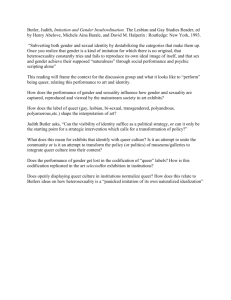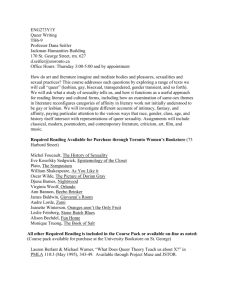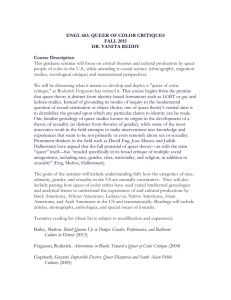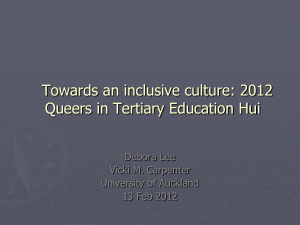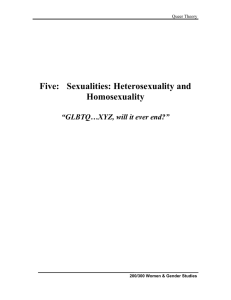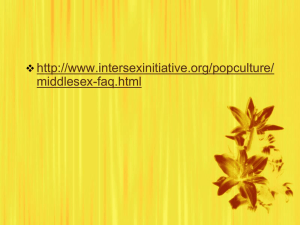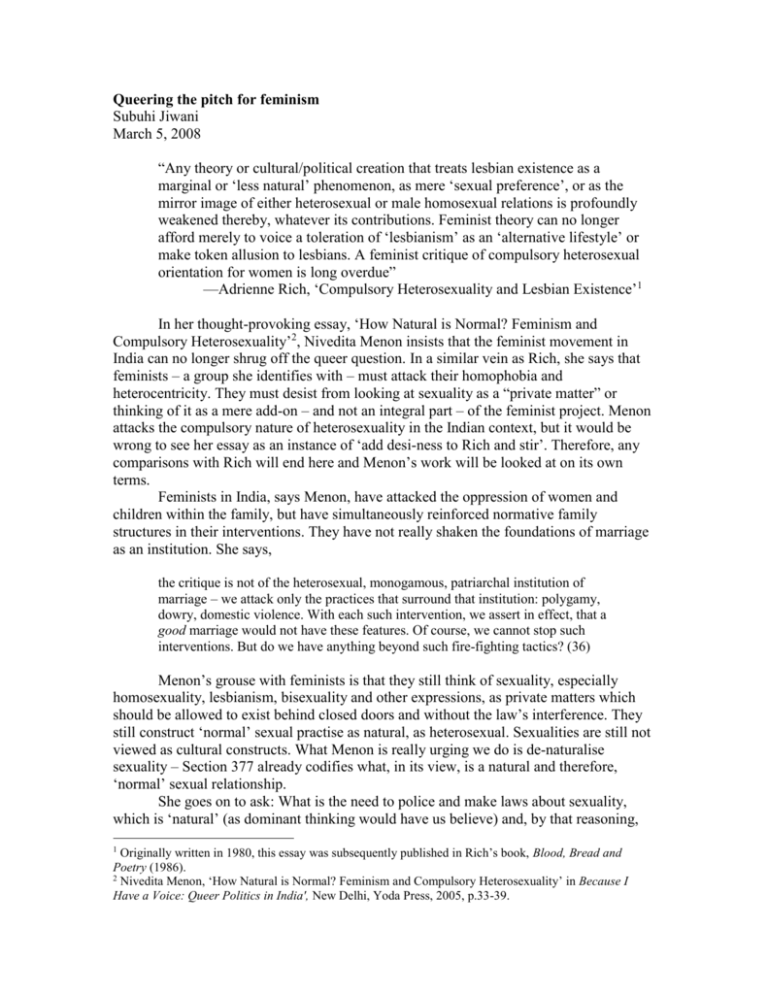
Queering the pitch for feminism
Subuhi Jiwani
March 5, 2008
“Any theory or cultural/political creation that treats lesbian existence as a
marginal or ‘less natural’ phenomenon, as mere ‘sexual preference’, or as the
mirror image of either heterosexual or male homosexual relations is profoundly
weakened thereby, whatever its contributions. Feminist theory can no longer
afford merely to voice a toleration of ‘lesbianism’ as an ‘alternative lifestyle’ or
make token allusion to lesbians. A feminist critique of compulsory heterosexual
orientation for women is long overdue”
—Adrienne Rich, ‘Compulsory Heterosexuality and Lesbian Existence’1
In her thought-provoking essay, ‘How Natural is Normal? Feminism and
Compulsory Heterosexuality’2, Nivedita Menon insists that the feminist movement in
India can no longer shrug off the queer question. In a similar vein as Rich, she says that
feminists – a group she identifies with – must attack their homophobia and
heterocentricity. They must desist from looking at sexuality as a “private matter” or
thinking of it as a mere add-on – and not an integral part – of the feminist project. Menon
attacks the compulsory nature of heterosexuality in the Indian context, but it would be
wrong to see her essay as an instance of ‘add desi-ness to Rich and stir’. Therefore, any
comparisons with Rich will end here and Menon’s work will be looked at on its own
terms.
Feminists in India, says Menon, have attacked the oppression of women and
children within the family, but have simultaneously reinforced normative family
structures in their interventions. They have not really shaken the foundations of marriage
as an institution. She says,
the critique is not of the heterosexual, monogamous, patriarchal institution of
marriage – we attack only the practices that surround that institution: polygamy,
dowry, domestic violence. With each such intervention, we assert in effect, that a
good marriage would not have these features. Of course, we cannot stop such
interventions. But do we have anything beyond such fire-fighting tactics? (36)
Menon’s grouse with feminists is that they still think of sexuality, especially
homosexuality, lesbianism, bisexuality and other expressions, as private matters which
should be allowed to exist behind closed doors and without the law’s interference. They
still construct ‘normal’ sexual practise as natural, as heterosexual. Sexualities are still not
viewed as cultural constructs. What Menon is really urging we do is de-naturalise
sexuality – Section 377 already codifies what, in its view, is a natural and therefore,
‘normal’ sexual relationship.
She goes on to ask: What is the need to police and make laws about sexuality,
which is ‘natural’ (as dominant thinking would have us believe) and, by that reasoning,
Originally written in 1980, this essay was subsequently published in Rich’s book, Blood, Bread and
Poetry (1986).
2
Nivedita Menon, ‘How Natural is Normal? Feminism and Compulsory Heterosexuality’ in Because I
Have a Voice: Queer Politics in India', New Delhi, Yoda Press, 2005, p.33-39.
1
not unlike bodily functions like eating or sleeping, which are ungoverned by laws? Her
answer is that sexuality, especially female sexuality, needs to be controlled. Within the
framework of heterosexual marriage, it not only determines through birth our caste, class
and community identities but also our citizenship. Thus the nation, community and caste
superiority bank on the woman’s ability to reproduce within a monogamous, heterosexual
marriage so that they can maintain and reinforce their ideologies. Homosexual and
lesbian relationships certainly pose a threat to this kind of silent arrangement.3
Finally, Menon raises a very pertinent question in her conclusion – how do we
understand queerness? – but answers it ambiguously and unsatisfactorily. She says:
“If we [feminists and others] recognise that ‘normal’ heterosexuality is painfully
constructed and kept in place by a range of cultural, bio-medical and economic
controls, precisely in order to sustain existing hierarchies of class and caste and
gender, then we would have to accept that all of us are – or have the potential to
be – ‘queer’.” (39)
Menon seems to be suggesting that if we can see through the naturalisation of
heterosexuality and recognise that sexuality as constructed, we might be able to consider
our own to be fluid, in-process and possibly queer. However, I am not sure that simply
challenging normative heterosexuality, which is at the heart of patriarchy, necessarily
makes us queer. It might in the eyes of those setting up the binary distinction between
normal and queer – if we’re not normal, we must be queer. It might, more importantly, if
we personalise it, if we are willing to admit that we do enjoy looking at (if not, fondling)
bodies of persons belong to the same sex as ours. Some of the questions I think we could
ask ourselves in this regard are: If/when our bodies are ‘read’ as heterosexual, would
those of us who do not identify as LGBT, challenge such a gaze? Is it enough to be queer
politically but not in bed? Are we still claiming some privilege if we adopt that term but
continue to live out our lives as straight or possibly sexually confused people? (It is also
possible that people who are LGBT might not overtly claim their sexuality in the public
space because of the fear of violence or ostracism.) Is our understanding of the term
queer located in the body or in identity, and does it need to be located in both?
Menon uses the term queer only in the very last line of her essay – it’s actually the
article’s very last word – but never really elaborates on what it might mean. I found
myself fumbling in the dark and my own friends’ referring to our other straight friends as
politically queer, only added to my confusion. So I turned to Annamarie Jagose’s article
‘Queer Theory’4.
Jagose says that queer has been on the one extreme, a slang for homosexual and
on the other, a homophobic slur. In recent times, it has come to connote “an umbrella
term or a coalition of culturally marginal sexual self-identifications [as well as] a nascent
3Despite
the legalisation of homosexuality and most recently, gay marriage in the West, the relationship in
question is still monogamous, even if it is non-heterosexual. I wonder how different the passing on of
property and inheritance is in gay and lesbian unions as compared to heterosexual ones. The real challenge
to the nation, community and state might arise from the complete jettisoning of marriage as a social
institution and its replacement by non-monogamous co-habitations.
3
Published in Australian Humanities Review, December 1996.
theoretical model which has developed out of more traditional lesbian and gay studies.”
And because queer does not refer to any specific identity category – she says it may
include lesbian, gay, bisexual, inter-sex, transgender, hermaphrodites, etc. – it can be
adopted by any number of debates, groups or individuals.
What’s most interesting is that Teresa de Lauretis, who first coined the term
‘queer’ – “another discursive horizon, another way of thinking the sexual” – gave it up
three years later because she felt that it had been co-opted by the very institutions it was
meant to resist. Interestingly, one of the anxieties that the term has given rise to, says
Jagose, is its almost unlimited constituency, which consists of many with less progressive
politics than those of people who might belong to the LGBT community, for instance.
That said, I do not intend to evaluate the progressiveness of LGBT politics versus
those of heterosexuals. I’d like to end this essay with a quote from Jagose’s paper so that
we might be able to continue thinking about what the term queer might mean and how it
is/can be used. It could, as my friend suggested, include in its fold a person who is
straight sexually but queer politically. And if this is the case, then Menon’s conclusion
should certainly disturb us to lesser degree.
… queer may be thought of as activating an identity politics so attuned to the
constraining effects of naming, of delineating a foundational category which
precedes and underwrites political intervention, that it may better be understood
as promoting a non-identity – or even anti-identity – politics. If a potentially
infinite coalition of sexual identities, practices, discourses and sights might be
identified as queer, what it betokens is not so much liberal pluralism as a
negotiation of the very concept of identity itself.

